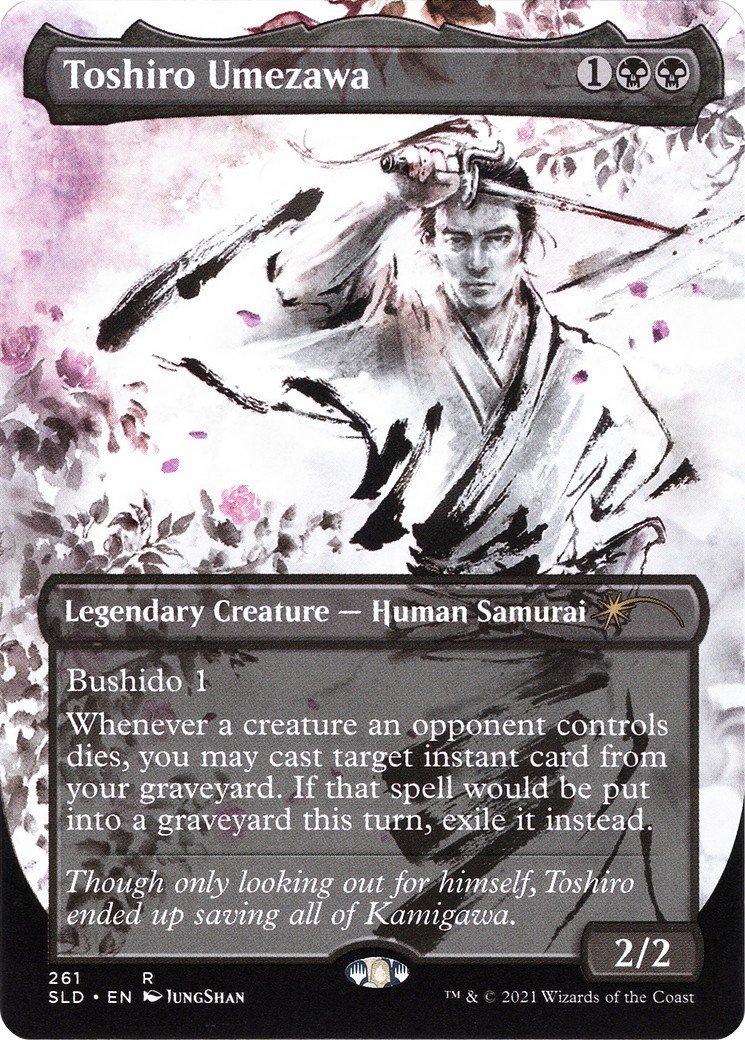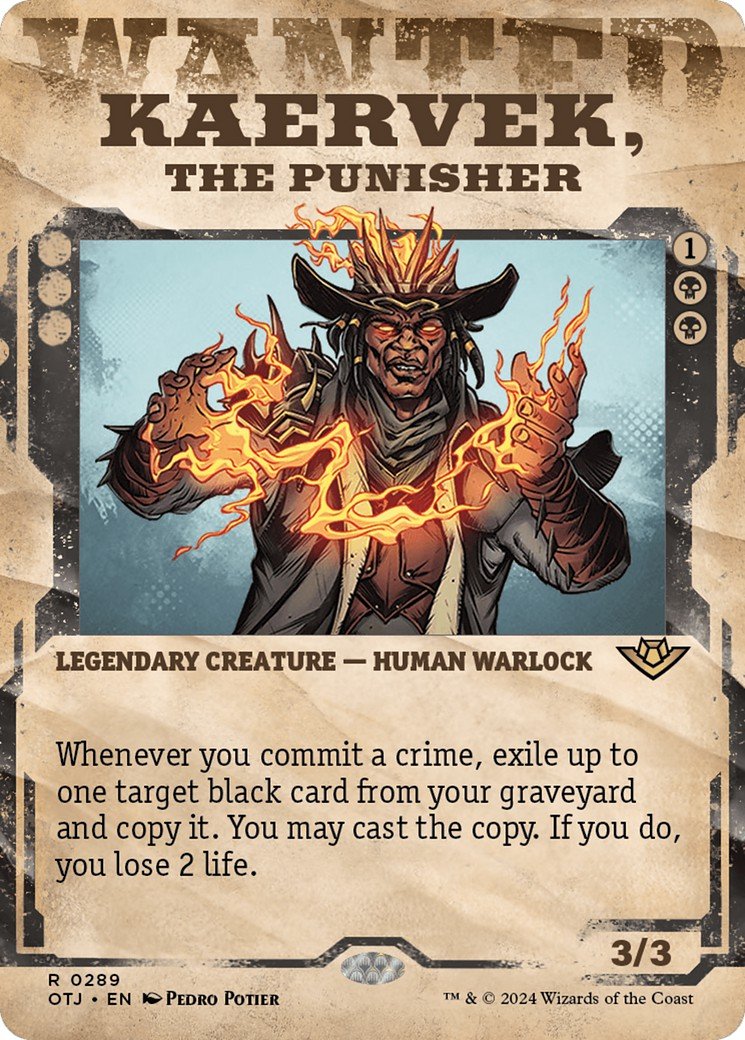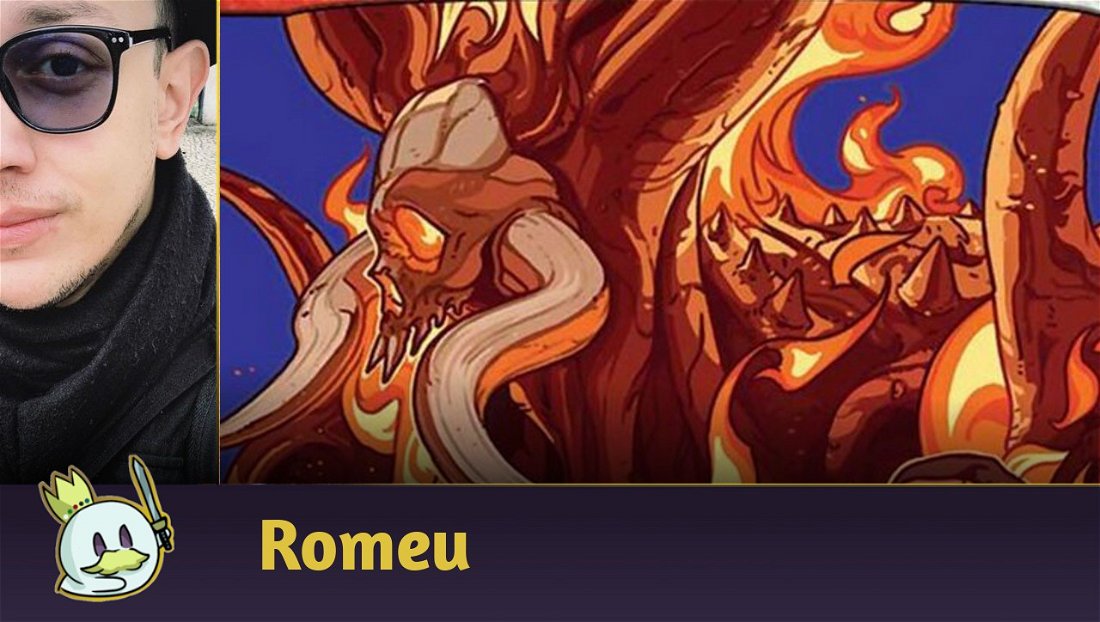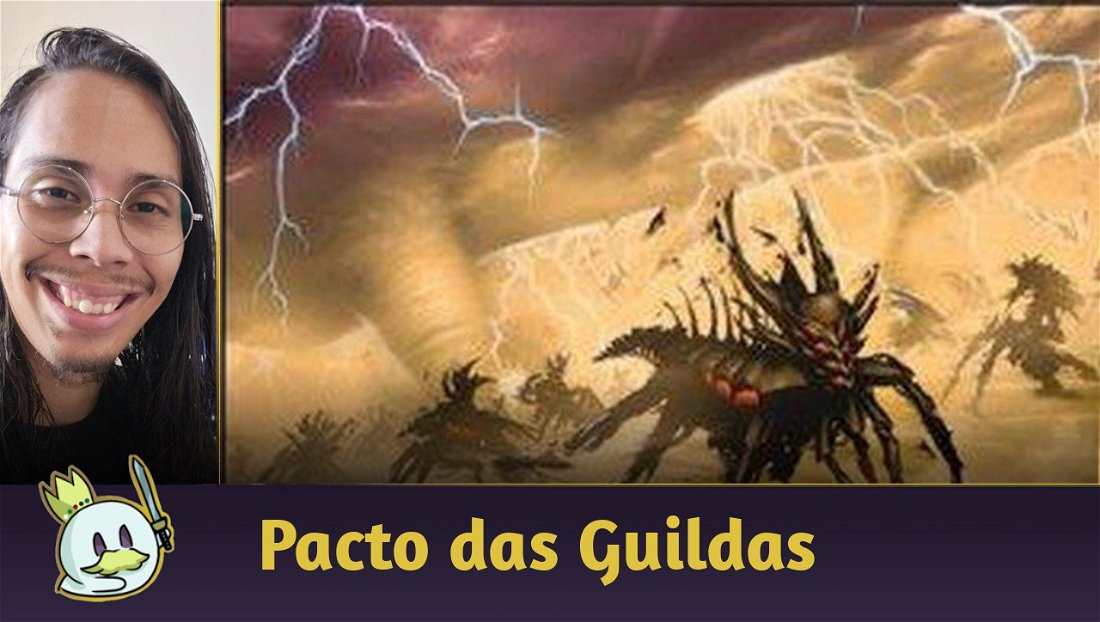In today's article, we'll show you how to play with one of the main Mirage War villains, Kaervek, the Punisher, who escaped his cell in Zhalfir and ended up in Thunder Junction. He was called there by Oko, who was planning a raid on Maag Taranau.
In Outlaws of Thunder Junction, we learned all about the strong rivalry between Satoru Umezawa and Kaervek, the Punisher. However, the only Umezawa that can actually rival Kaervek in real Magic: The Gathering matches is Toshiro Umezawa, who sat at the center of one of the most efficient spellslinger control black decks of its time.


They're different cards, with incredibly elegant designs, but, even though I highly respect Toshiro Umezawa, Kaervek, the Punisher is superior on all fronts.
The fact that he triggers any time you commit a crime, and like so also targets any black card in your graveyard, opens a sea of possibilities that just aren't there when you play the old Samurai, Umezawa. Losing two life when you play the copy of the cards you exiled is a small punishment considering the enormous reward you'll get in exchange.
About the Deck
The biggest weapon this Spellslinger has is the fact you'll double the value of your cards when you play them again from your graveyard onto the battlefield. Kaervek, the Punisher also lets you play spells at a different speed than usual, considering you need to cast them when Kaervek's ability resolves on the stack.
So we can cast permanents, sorceries, and whatever we need to win whenever we interact with him.

With all of this in mind, I decided to use several Edicts, many of them creatures. With them, we'll control the size of the battlefield with an iron fist. We also added different types of removals and cards to Commit Crimes - this means targeting opponents, anything they control, and/or cards in their graveyard. Copies of their permanent spells will become tokens.
Kaervek, the Punisher Deck
Mana Base
This deck focuses on interactions. To do this, we need a lot of mana available quite fast; otherwise we won't be able to control the game the way we want to.
We decided to use a smaller number of lands themselves because we wanted to have more alternative mana sources, and this way play more than one mana per turn. In that same sense, we added a few staples like Bojuka Dog, Reliquary Tower, and Castle Locthwain.
Additionally, we also had to add swamps and snowy permanents because of Dead of Winter, which is a powerful version of Mutilate; they'll help us on curves 


Our cards cost an average of 
Accelerators
We'll also use many low-cost mana rocks and cards that reduce our costs to play faster and more consistently. Treasure tokens will help us maintain an efficient game rhythm as well. Grim Hireling, usually, will give us up to 

Because we can play our rituals several times, and the fact that they're very versatile, they were perfect for our mana base. Any time you play them, your commander will affect the game state and significantly tip the scales to your favor.
Ashnod's Altar and Pitiless Plunderer are powerful mana engines, particularly when you combine them with the extra bodies you'll create (your tokens), and the creatures you'll take from your opponents.
Extra Resources
Kaervek, the Punisher's ability turns life into extra resources. We need to make sure we extract as much as we can out of these resources and justify risking our life to get them. So, we added some extra lifegain to keep ourselves as healthy as possible.

Limiting what your opponents can play and getting even more sources for yourself is a sort of "resource drain". It is more than just "draining life points", as it also a way to interact with their creatures and other permanents.
Tergrid, God of Fright and Gisa, Glorious Resurrector are decisive in this sense.

Card Draw
One of this deck's greatest strengths is how it doubles the number of cards you draw. Additionally, you'll create even more value and advantage when you draw these cards from unusual places, like the graveyard: This completely breaks the standards for how many resources players usually get when they get extra cards, tempo, and other tools.

Peer into the Abyss is one of the best ways to draw cards in the entire game. It exchanges half your life for half your deck, it is much more efficient than Necrologia, and rivals the powerful Ad Nauseam. And there's more: at the end of the turn, even if you end up discarding a few extra cards, you can just play them later when you find an opportunity.

Card Selection
I'm a great fan of the Transmute mechanic ever since it was released, in Ravnica: City of Guilds. To me, cards such as Grim Tutor look like an address. Netherborn Phalanx will get us Tetzimoc, Primal Death, Dimir House Guard will get us Grim Hireling, and Dimir Machinations will get us Varragoth, Bloodsky Sire.
These are my typical choices, but you are welcome to see these cards as the "holster" for our "silver bullets" - Shred Memory is my favorite in this sense.

Recursion
In a way, Kaervek, the Punisher is a miniature version of Yawgmoth's Will in our command zone. And, because of this, we don't have to play many cards similar to them among our other 99 cards.
However, we added Victimize, which will get you two creatures for very little mana, and also put another resource in our graveyard for later. Malakir Rebirth, a modal spell, will let you execute impressive combat tricks.

Interactions
Interacting with our opponents is the best way to commit a crime. By just draining their resources, we'll get to play the cards in our graveyard once again, which will give us an extra advantage.
Hex Parasite and Merrow Bonegnawer are consistent ways to access the spells in our graveyard. Grim Hireling and Tetzimoc, Primal Death also stand out.
Target Removals
Black has numerous removals - we divided them into two types. Direct removals, like Defile and Baleful Mastery, and Edicts; cards that force our opponents to sacrifice one or more permanents.
As our direct removals, we added cards that cost 


The fact we can play the same card twice because of our commander makes cards like Plaguecrafter incredibly powerful. However, there are only a few cards that are as powerful as Priest of Forgotten Gods in this sense.

Its activated ability, even though it is expensive, will give you so much value it earned it a spot on our list. Its text states "any number of target players" - so, it commits a crime. It is simply perfect.

Global Removals
Because this format is full of evasion and protection, we had to add a specific type of global removal: the ones that reduce toughness without actually dealing damage, or the ones that force our opponents to sacrifice their permanents.
Make an Example is a great Edict. When we combine it with Tergrid, God of Fright, and Gisa, Glorious Resurrector, its effect is simply devastating.

Protection
We decided the best way to use protection would be to use it on our resources, as this way we'll be able to set up explosive turns without any issues.
Conqueror's Flail is ideal; it is a stax piece that protects you against counters, and Hope of Ghirapur will do the same and also lock down your most reactive opponent. Our commander is a value engine, so Swiftfoot Boots will keep him on our board.

High Power Alternative Kaervek, the Punisher Deck
This list is an upgrade of our initial budget list, if you don't have a budget. Its power level is quite high, as it includes many combos. You might say that, with just a few changes, this list is a perfect example of a cEDH Midrange; it is an optimized deck that wants to win all its matches.
Final Words
Kaervek, the Punisher is a consistent commander: it brings a lot as a spellslinger commander in these colors. Its predecessor, Toshiro Umezawa, is certainly a strong addition to his deck, and vice versa. Be it on competitive or casual boards, he is an excellent choice for those who want to play it safe, bit by bit.
When this article was written, this deck cost around $200, but this may vary, as we all know.
Thank you for reading, and good luck on your games!
If you have any questions, I'll be in our comment section below.
See you next time!















— Comments 0
, Reactions 1
Be the first to comment